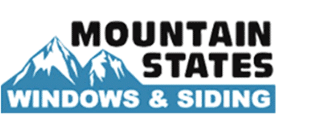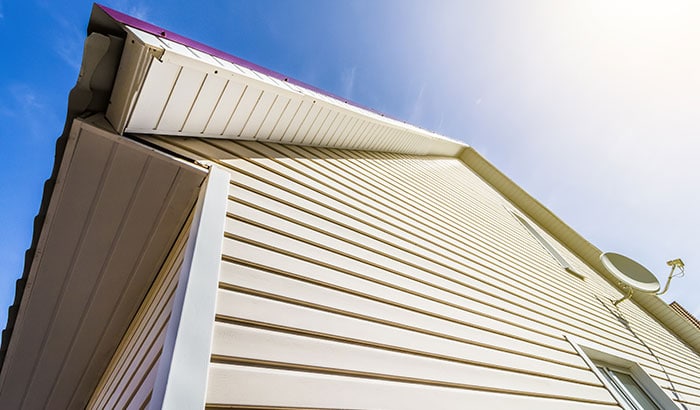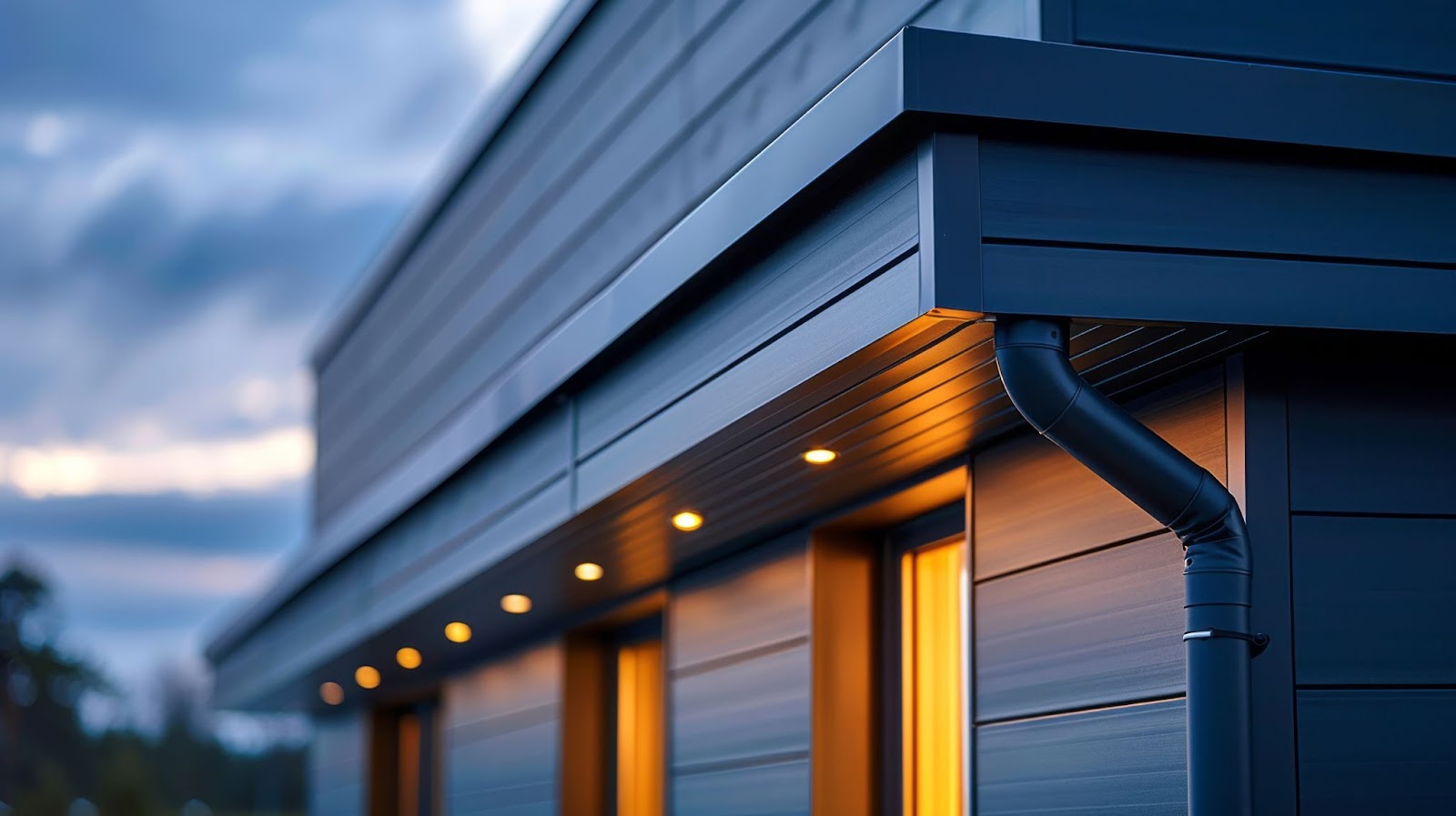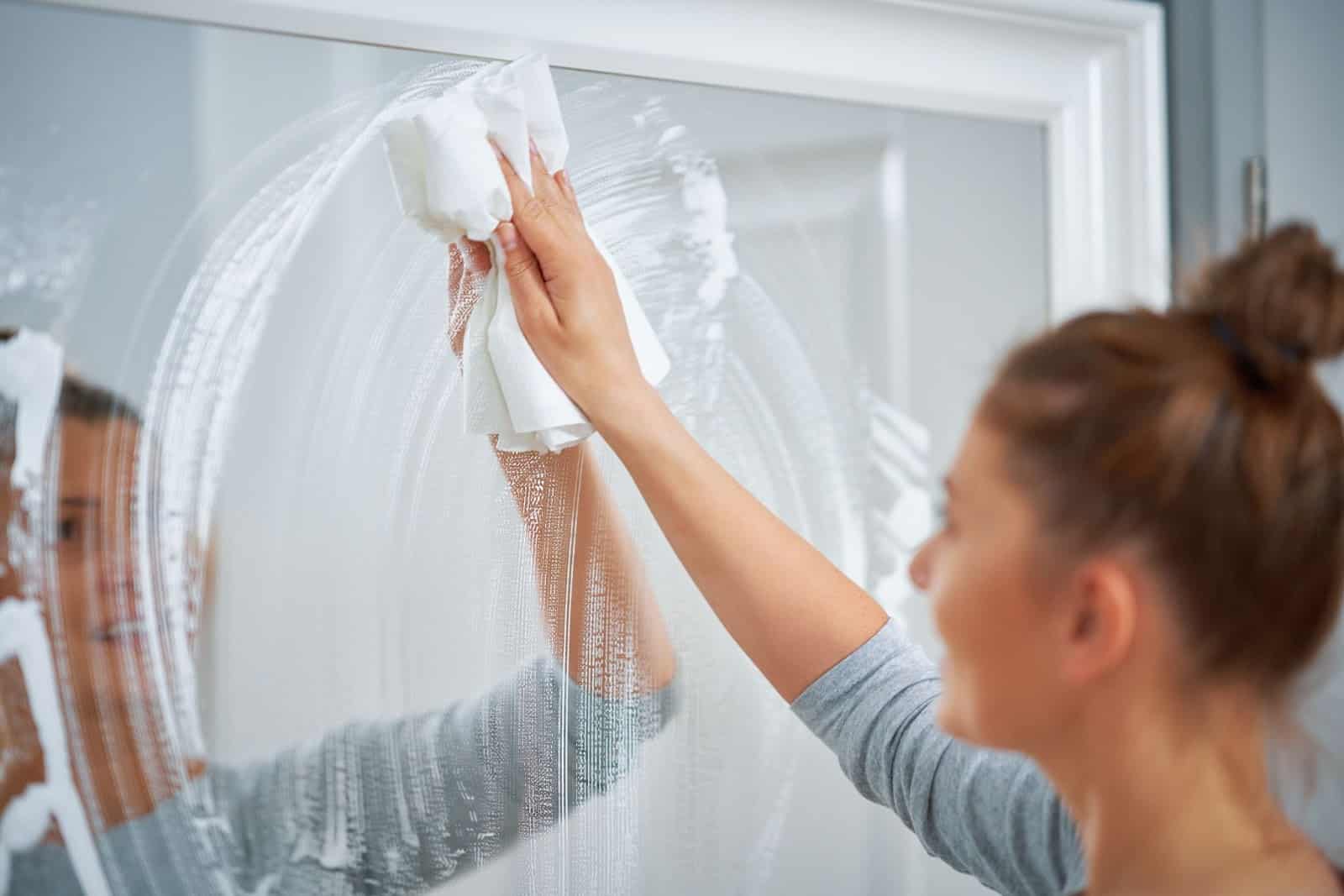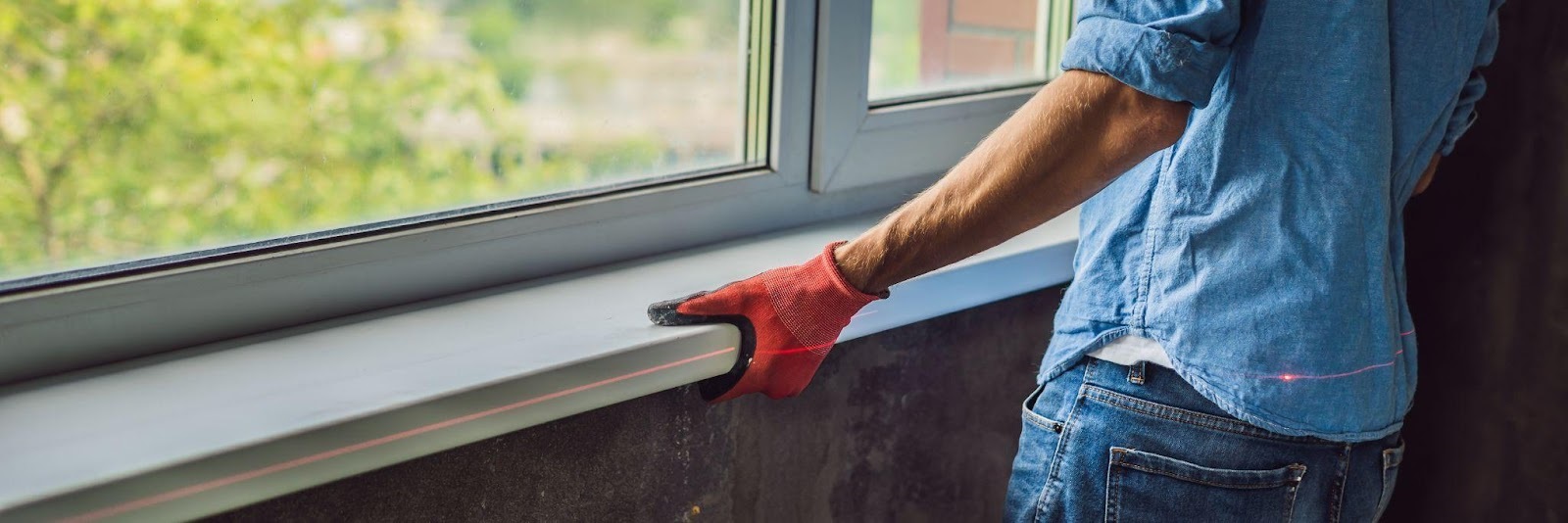Did you know that your siding is often the first impression of your house and its first defense against the elements? As such, choosing durable and aesthetically-pleasing siding can make or break your home.
Thankfully, there are plenty of siding types out there, so you’re sure to find the right siding for your home.
To ensure that you get what’s best for your home, be sure you know your options — and the pros and cons of those siding types. If you’re going for style and durability, we have a few suggestions.
Your best options include vinyl, brick, wood, synthetic stone, fiber cement, stucco, and engineered wood siding
Keep reading to learn more about each type of siding and its pros and cons so that you can make an informed decision for your home.
1. Vinyl Siding
Vinyl siding is a popular, cost-effective exterior cladding used on homes and commercial buildings. It is made from PVC (polyvinyl chloride) resin and is designed to mimic the look of traditional wood siding without the maintenance and upkeep required for natural wood.
Vinyl siding is available in a wide range of colors, textures, and styles, making it a versatile choice for any type of architecture. It is also easy to install and can usually be applied directly over existing siding, reducing installation time and costs.
One of the key benefits of vinyl siding is its durability. Vinyl siding is resistant to pests (think termites), which can cause damage to natural wood siding. It is also resistant to fading, cracking, and warping. It can withstand extreme weather conditions like high winds, hail, and heavy rain, which is something to consider if you live in an area that’s frequently subject to those weather conditions.
In terms of maintenance, vinyl siding is relatively low-maintenance compared to natural wood siding. It does not require painting or staining and can be easily cleaned with soap and water. This makes it a popular choice for homeowners who want a beautiful, durable exterior without the hassle of maintenance.
Overall, vinyl siding is a versatile and durable option for exterior cladding that offers many benefits, such as low maintenance, durability, and a wide range of styles and colors.
2. Brick Siding
Brick siding is one of the most popular types of siding and has been used for centuries. It is made from clay or other natural materials that are fired at high temperatures to create a hard, dense material resistant to weathering, pests, and fire.
One of the main benefits of brick siding is its durability. It is one of the most long-lasting options for exterior cladding, with a lifespan of up to 100 years or more. Plus, brick siding requires minimal maintenance, only needing occasional cleaning to maintain its appearance.
Another benefit of brick siding is its energy efficiency. It provides excellent insulation, helping to keep a home warm in the winter and cool in the summer. This can reduce energy costs and improve the overall comfort of a home.
Brick siding is also a versatile option, available in a range of colors and styles. It can be laid in a variety of patterns, allowing homeowners to achieve a specific look that complements the architecture of their home. Brick siding is often considered a timeless choice, adding value and aesthetic appeal to a home.
One potential drawback of brick siding is its cost. It can be more expensive than other types of siding, both in terms of material and installation costs. However, the durability and longevity of brick siding can make it a worthwhile investment for many homeowners.
Overall, brick siding is a strong and attractive option for exterior cladding, offering many benefits such as durability, energy efficiency, and versatility. While it may be more expensive than other options, its long lifespan and low maintenance requirements can make it a cost-effective choice in the long run.
3. Wood Siding
Wood siding is another one of the popular types of siding, offering traditional and natural exterior cladding. It is available in cedar, pine, redwood, and more, each with unique characteristics and appearances. Wood siding can be installed in various styles, including shiplap, clapboard, and board-and-batten, and can be painted or stained in various colors.
One of the most significant benefits of wood siding is its beauty. Natural wood siding has a warmth and character that other materials cannot match, creating an inviting and cozy atmosphere for a home. Wood siding is also a sustainable and renewable resource, making it an environmentally friendly choice for homeowners.
However, wood siding does require more maintenance than other types of siding. It must be regularly painted or stained to protect it from moisture and different types of damage. It can be susceptible to pests and may be more expensive than other types of siding.
Overall, wood siding is a beautiful and natural option for exterior cladding that offers many benefits, such as sustainability and versatility in style and color. While it requires maintenance, many homeowners find the timeless beauty of wood siding worth the investment.
4. Synthetic Stone Siding
Also known as faux stone siding, synthetic stone is an alternative option for exterior cladding that offers the look of natural stone without the cost and maintenance requirements. It is made from a mixture of cement, aggregates, and pigments that are molded and textured to resemble natural stone.
One of the main benefits of synthetic stone siding is its affordability. It is significantly less expensive than natural stone, making it a popular choice for homeowners who want the look of stone without the high cost.
Synthetic stone siding is lightweight and easy to install, reducing labor costs and installation time. Synthetic stone siding is also durable and low-maintenance, requiring only occasional cleaning to maintain its appearance. It is resistant to weather, pests, and fire, making it a safe and long-lasting option for exterior cladding.
Regarding aesthetics, synthetic stone siding is available in a wide range of styles and colors to suit any type of architecture. It can be used to create a variety of looks, from rustic to modern, and can be installed in a variety of patterns to create unique visual effects.
Overall, synthetic stone siding is a cost-effective and low-maintenance option for exterior cladding that offers the beauty and durability of natural stone. While it may not have the same level of authenticity as natural stone, it is a practical and attractive alternative for many homeowners.
5. Fiber Cement Siding
Fiber cement siding is a popular and durable option for exterior cladding made from cement, sand, and cellulose fibers. It is available in various styles, including shingles, panels, and lap siding, and can be painted or stained in multiple colors.
One of the main benefits of fiber cement siding is its durability. It is resistant to moisture, fire, pests, and rot, making it a long-lasting option for exterior cladding. Additionally, fiber cement siding requires minimal maintenance, only needing to be cleaned periodically to maintain its appearance.
Another benefit of fiber cement siding is its versatility. It can be designed to mimic the appearance of other materials, such as wood or stucco, allowing homeowners to achieve a specific look without the cost or maintenance requirements of the natural materials. Fiber cement siding is also available in a variety of textures and finishes, allowing for further customization.
Fiber cement siding is an environmentally friendly option, made from sustainable materials and 100% recyclable. It can contribute to a home’s energy efficiency, as it provides excellent insulation and can help reduce energy costs.
While fiber cement siding can be more expensive than other types of siding, its durability, low maintenance requirements, and versatility make it a worthwhile investment for many homeowners.
Overall, fiber cement siding is a strong and attractive option for exterior cladding that offers many benefits, such as durability, versatility, and eco-friendliness.
6. Stucco Siding
Stucco siding is a popular and versatile option for exterior cladding. It is made from a mixture of cement, sand, and water, which is applied in multiple layers to create a durable and long-lasting finish.
One of the main benefits of stucco siding is its durability. It is resistant to weathering, pests, and fire, making it a practical and safe option for exterior cladding. Stucco siding is low-maintenance, only requiring occasional cleaning to maintain its appearance.
Another benefit of stucco siding is its versatility. It can be applied in various textures and finishes, allowing homeowners to achieve a specific look that complements the architecture of their home. Stucco siding is also available in a range of colors and can be painted to customize its appearance further.
Stucco siding is also an energy-efficient option, as it provides excellent insulation and can help reduce energy costs. This can be particularly beneficial in areas with extreme temperatures, as stucco siding can help keep a home cool in the summer and warm in the winter.
While stucco siding can be more expensive than other types of siding, its durability, low maintenance requirements, and energy efficiency make it a worthwhile investment for many homeowners.
Overall, stucco siding is a strong and attractive option for exterior cladding that offers many benefits, such as durability, versatility, and energy efficiency.
7. Engineered Wood Siding
Engineered wood siding is an alternative for exterior cladding made from wood fibers, resins, and other materials. It is designed to replicate the look of natural wood while providing increased durability and resistance to the elements.
One of the main benefits of engineered wood siding is its affordability. It is less expensive than natural wood siding, making it a popular choice for homeowners who want the look of wood without the high cost. Additionally, engineered wood siding is lightweight and easy to install, reducing labor costs and installation time.
Engineered wood siding is also durable and low-maintenance, requiring only occasional cleaning to maintain its appearance. It is resistant to pests, rot, and decay, making it a safe and long-lasting option for exterior cladding.
Regarding aesthetics, engineered wood siding is available in various styles and finishes, including shingles, panels, and lap siding. It can be painted or stained in a range of colors to suit any type of architecture. Additionally, engineered wood siding is often pre-primed, reducing the time and cost of painting or staining.
Another benefit of engineered wood siding is its eco-friendliness. It is made from sustainable materials and can be recycled at the end of its life, reducing waste and environmental impact.
Overall, engineered wood siding is a cost-effective and low-maintenance option for exterior cladding that offers the beauty and warmth of natural wood. While it may not have the same level of authenticity as natural wood, it is a practical and attractive alternative for many homeowners.
Have Mountain States Windows & Siding Install Your Home’s Siding
Are you comparing siding types to decide which would look best for your home? Call in the professionals to help!
Located in Lehi, Utah, and serving homes from Spanish Fork to Salt Lake City, Mountain States Windows and Siding is here to help you bring your dream home to life. Let us impress you with our wide selection of siding options for your home.
Are you ready to get started on your home siding project? Contact us today or call us at 801.572.8039 to learn more, or stop by our showroom. We can’t wait to meet you!
